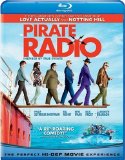We are in the mid-60s, when, during the glory days of the Stones, the Who, and other colossi of British rock, the BBC allows almost no airplay of said music. To the rescue comes a group of commercial pirate radio stations, broadcasting from ships off the coast. Priggish minister Kenneth Branagh is determined to shut them down, and our focus is on one particular ship, run by Bill Nighy, and boasting such luminaries as Philip Seymour Hoffman and Nick Frost as DJs. Onto this ship of counter-culture rebels comes a young Tom Sturridge, and this wet-behind-the-ears youth becomes the eyes through which we watch the various eccentric goings-on.
Director Richard Curtis is a dab hand at ensemble romantic comedies, as the sterling likes of Four Weddings and a Funeral and Love Actually more than demonstrate. But though he has a terrific cast here, including such regulars as the always watchable Nighy, this is a misfire. It is surprising, given some of the indelible characters in Curtis’ previous films (notably Emma Thompson’s role in Love Actually) that the female parts here are so woefully underwritten (the women in this film are little more than disposable sex objects). As well, would-be funny scenes of the farcical, slamming-door variety (such as the scene where Frost tries to get the virginal Sturridge to replace him in bed) are older than the hills and eroded completely flat. So the comedy, the odd line here and there notwithstanding, barely raises more than a mild grin. And the tone is so light and unconcerned that it robs the context of any real rebellion or vitality. This radio station might as well be a standard classic-rock denizen of the FM band for all the edge we feel. Then there’s some laziness to the writing. If we are to believe this is circa 1966, why have someone anachronistically talk about “thinking outside the box”?
This is the North American cut of the film, cut down to 117 minutes from the original 135 of the British release. I’m never a fan of bowdlerization, but by the same token, I’m not convinced another 18 minutes of low-key meandering would make things better.
Video
Uninspiring though the film may be, it is still a slick, professional package, and that professionalism certainly is evident in the picture quality. The blacks are so profound as to be almost sublime, though without a trace of murk. Contrasts are excellent, grain and edge enhancement are banished from human ken, and the image is perfectly sharp. The film’s original aspect ratio of an anamorphic 2.35:1 is respected. Lovely to watch.
Audio
Very nice work here, too. The music has a great, rich sound (obviously far better than all those extras grooving to their transistor radios would be experiencing). The sound effects are spectacular, with excellent immersive qualities and left-right separation (at one point, when I was listening to part of the film with headphones, I heard a sound to my right, and wondered what was going on, at first not thinking it was coming from the movie at all, before I realized I was hearing the subtle touch of the ship’s creaking). My one niggling complaint is that some of the surround elements are a little too omnipresent. There’s a camera shutter sound early on that shouldn’t really be coming from the rear.
Commentary Track: Here we have Curtis, actors Frost and Chris O’Dowd, and producer Hilary Bevan Jones. Much joking around here, but the track is pleasant enough and informative enough.
Special Features
Deleted Scenes: (68:34) 16 of them, most introduced by Curtis, and showing that the film was initially even more randomly plotted than it is now.
Making-of Featurettes: (19:38) Six featurettes may sound like quite a bit, until you check the running time and realize that averages out to little more than three minutes each. Standard promotional fare.
BD-Live.
Final Thoughts
A disappointment, then, though not actively painful to sit through. Still, given the talent on both sides of the camera, it should be better. Not to mention the fact that it is based on a pretty fascinating piece of history, which leads to me to conclude with another example of a missed opportunity: where are the features that would tell us a lot more about the real pirate radio ships?





